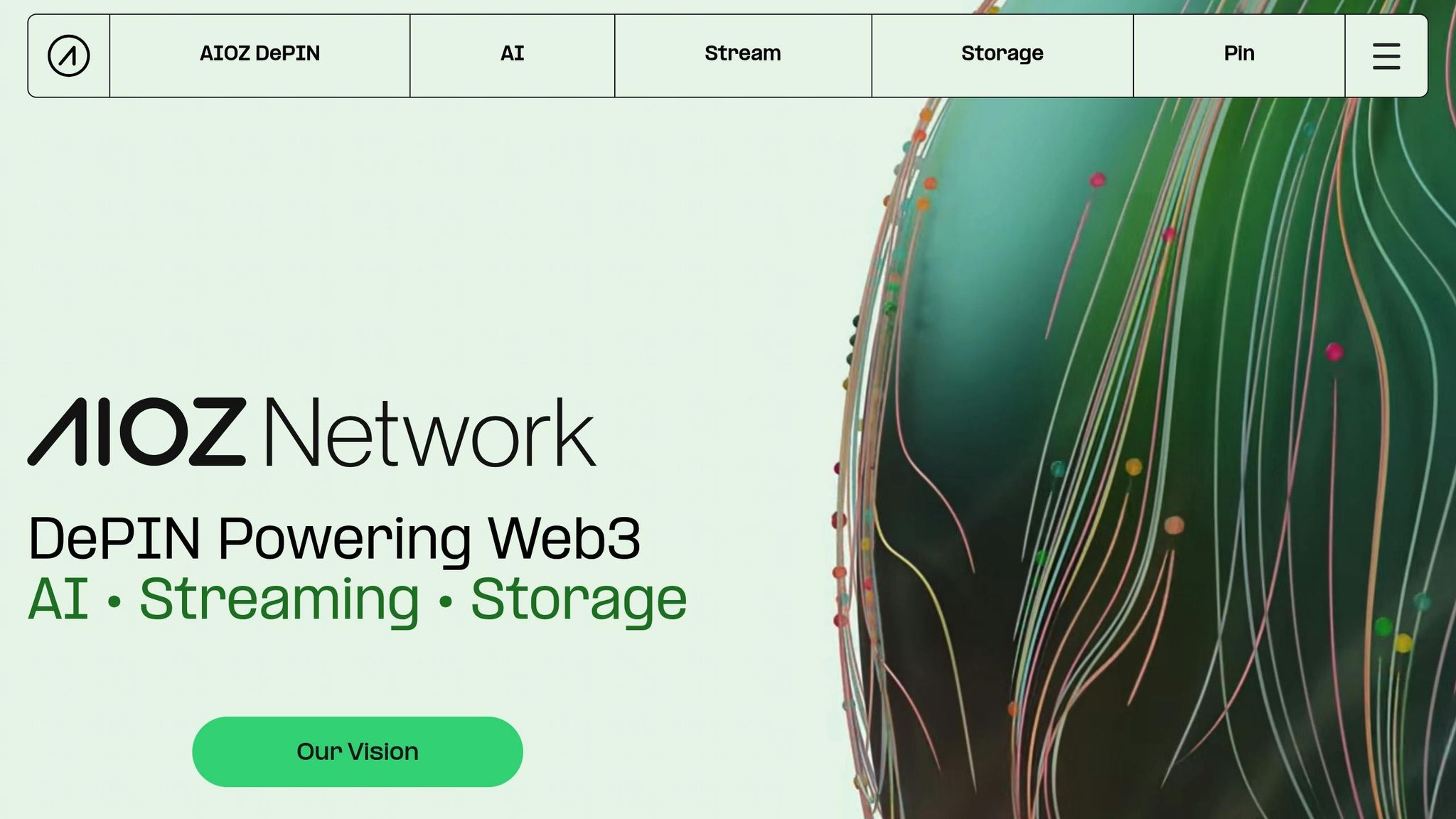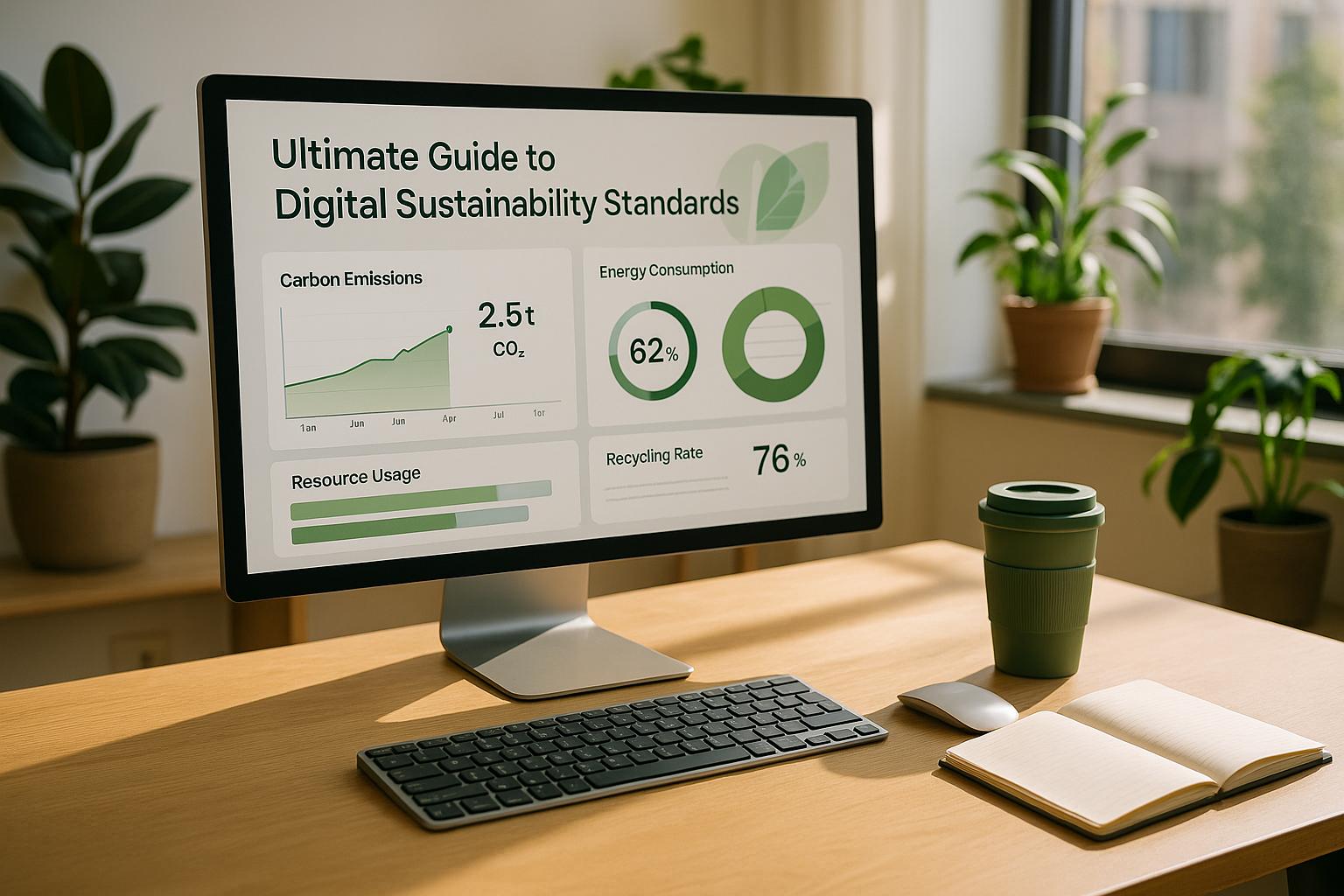Blockchain is transforming content delivery. Unlike older systems, blockchain-based Content Delivery Networks (CDNs) are decentralized, secure, and efficient. Here's what you need to know:
- What it is: Blockchain CDNs use a peer-to-peer network and smart contracts to store and deliver content without relying on centralized servers.
- Why it matters: They reduce latency (down to 20–50 miles), improve security, and ensure transparency with immutable records.
- Key benefits: Better performance, cost savings, and automated royalty payments for creators.
- Challenges: Scalability issues, high setup costs, and regulatory uncertainty.
- Industries using it: Gaming, media, healthcare, and e-commerce are already seeing improved reliability and reduced costs.
Blockchain CDNs are reshaping how content is distributed, offering faster, more secure, and transparent solutions. However, adoption depends on overcoming technical and regulatory hurdles.
Potential 100x Crypto Sleeping CDN Giant : AIOZ Network 🚀

Core Components and Architecture of Blockchain CDNs
Blockchain CDNs rely on a decentralized framework to deliver content in a way that's both efficient and secure.
Peer-to-Peer Network Structure
The backbone of a blockchain CDN is its peer-to-peer (P2P) network. In this setup, every participant functions as both a client and a server, sharing resources directly without needing a central authority. This is a departure from the traditional client-server model, where a central server handles all content distribution.
Several key elements make P2P networks work effectively:
- Peer Nodes: These nodes store and distribute content. By replicating popular content across multiple nodes, the system ensures faster access and greater reliability.
- Overlay Networks: These facilitate seamless communication between peers and optimize resource sharing. They help peers locate and connect with one another efficiently.
- Indexing Mechanisms: These serve as a catalog for shared resources, enabling quick and accurate content retrieval. Without proper indexing, finding specific content in a decentralized setup would be a significant challenge.
- Bootstrapping: This process allows new nodes to join the network quickly by connecting with existing nodes.
P2P networks have a natural advantage when it comes to scalability. Unlike traditional CDNs, which require hefty investments to expand infrastructure, P2P networks grow as new peers join, each contributing additional capacity. However, the network's performance hinges on the number of active peers and the bandwidth they can provide.
Next, let’s explore how smart contracts streamline operations and incentivize participation in this decentralized system.
Smart Contracts and Incentive Models
Smart contracts are the driving force behind the automation in blockchain CDNs. These self-executing agreements handle essential tasks, such as verifying user permissions and granting content access once payments or other conditions are met. They also ensure creators are compensated promptly and fairly, streamlining the reward process.
Take Tune.fm as an example. This platform uses smart contracts for tokenized music streaming and NFT-based exclusive content, guaranteeing that artists are paid directly. By automating payments and royalties, smart contracts eliminate the delays and disputes common in traditional content distribution systems.
The influence of smart contracts extends far beyond content delivery. By mid-2024, the decentralized finance market powered by these contracts had surpassed $150 billion in total value locked. Moreover, Gartner predicts that by 2025, 10% of all business contracts worldwide will be executed using blockchain-based smart contracts, a sharp rise from less than 1% in 2021.
These automated processes are crucial to the roles played by different stakeholders in the blockchain CDN ecosystem.
Key Players in the Blockchain CDN Ecosystem
The effectiveness of blockchain CDNs depends on a variety of stakeholders, each contributing to the network's success:
- Content Creators: These individuals or organizations produce content and are compensated transparently via smart contracts.
- Consumers: End users benefit from enhanced privacy through anonymized transactions while accessing high-quality, authentic content. Blockchain CDNs also help curb piracy and unauthorized sharing.
- CDN and Node Operators: These participants manage the network infrastructure by running nodes, validating transactions, and ensuring the system's stability and security. They are rewarded for their contributions, aligning their efforts with the network's health.
- Developers: Responsible for creating and updating the system's code, developers ensure the network remains secure, efficient, and ready to tackle new challenges.
- Validators and Miners: By staking cryptocurrency or dedicating computational power, these stakeholders validate transactions and add new blocks to the blockchain, securing the entire content delivery and payment process.
Collaboration among these groups is essential for maintaining a balanced and efficient ecosystem. Together, they create a content delivery network that's more transparent, resilient, and efficient than traditional centralized models.
Benefits and Challenges of Blockchain CDNs
Blockchain CDNs bring a fresh approach to content delivery, offering distinct advantages while also presenting challenges that businesses need to consider before adopting this technology.
Benefits of Blockchain CDNs
Stronger Security and Resilience: Blockchain CDNs excel in security by using distributed nodes to handle traffic. This setup minimizes the impact of DDoS attacks by spreading the load across multiple points, making such disruptions far less effective. Additionally, the decentralized structure eliminates single points of failure. If one node goes offline, the network continues to function seamlessly, ensuring consistent uptime and reliable delivery - critical for businesses that can't afford interruptions.
Transparency and Content Protection: Blockchain technology provides immutable records of every content access and distribution event. This level of transparency allows businesses to track how their content is used and ensures it remains unaltered during delivery. For companies dealing with sensitive or high-value digital assets, this is a game-changer.
Cost Savings: By reducing reliance on expensive centralized infrastructure and cutting out intermediaries, blockchain CDNs can help lower operational costs. The peer-to-peer nature of these networks also enables businesses to utilize unused bandwidth and storage at more competitive rates compared to traditional CDN providers.
Streamlined Operations: Blockchain CDNs simplify processes like payment handling, content authorization, and rights management through automation. This efficiency reduces administrative burdens and speeds up operations, making workflows smoother and more efficient.
Challenges and Limitations
While the benefits are promising, blockchain CDNs come with their own set of hurdles.
Scalability Concerns: One major challenge is the limited transaction capacity of blockchain networks. For example, Bitcoin processes about 7 transactions per second, and Ethereum handles around 30, compared to Visa’s capability of up to 24,000 transactions per second. The need for every node to validate each transaction slows down the system, which can be a deal-breaker for businesses requiring large-scale, high-speed content delivery.
High Implementation Costs: Adopting blockchain CDNs can be expensive. Beyond purchasing the technology, businesses face costs for installation, energy usage, staff training, and compliance. These expenses may be prohibitive for smaller companies.
Regulatory Uncertainty: The lack of clear regulations around blockchain technology in many regions complicates long-term planning. Businesses may hesitate to invest heavily without knowing how future rules might impact them.
Awareness and Trust Issues: Many businesses are still skeptical about blockchain due to concerns over security, privacy, and reliability. This lack of trust slows adoption and often requires significant educational efforts to address misconceptions.
Integration Challenges: Blockchain technology doesn’t always play well with legacy systems. For companies relying on older infrastructure, integrating blockchain CDNs can be a complex, time-intensive, and costly process.
Despite these obstacles, the potential for blockchain remains immense. Gartner predicts blockchain-related business value will grow to $176 billion by 2025 and $3.1 trillion by 2030. Similarly, the global CDN market is expected to expand from $21.7 billion in 2023 to $36.5 billion by 2030.
Comparison Table: Blockchain CDNs vs. Standard CDNs
Here’s a quick look at how blockchain CDNs stack up against traditional CDNs:
| Feature | Traditional CDN | Blockchain-Based CDN |
|---|---|---|
| Infrastructure | Centralized servers in data centers | Decentralized peer-to-peer network |
| Security | Vulnerable to DDoS and single failures | Stronger security via decentralization and cryptography |
| Transparency | Limited visibility | Full transparency with immutable records |
| Cost Structure | Fixed pricing based on usage | Lower costs through resource sharing and fewer middlemen |
| Resilience | Single point of failure risks outages | Resilient to node failures |
| Scalability | Easily scales with added servers | Limited by blockchain transaction speeds |
| Implementation | Simple integration | Complex setup requiring specialized expertise |
The decision between traditional and blockchain CDNs boils down to your business needs. If security, transparency, and decentralization are top priorities, blockchain CDNs offer a compelling option. However, for high-speed, large-scale content delivery, traditional CDNs might remain the better choice - at least until blockchain scalability improves.
sbb-itb-01010c0
Implementation Strategies for Blockchain CDNs
Bringing blockchain CDNs to life involves more than just understanding their architecture and benefits. It requires careful planning, precise execution, and a solid grasp of blockchain technology and content delivery systems. The process spans several phases, each with unique challenges and best practices, from initial setup to ongoing adjustments.
Step-by-Step Deployment Process
Phase 1: Platform Selection and Architecture Design
The first step is choosing the right blockchain platform for your CDN. Factors like scalability, security, consensus mechanisms, and ecosystem support play a major role here. Opting for platforms with proven security records helps safeguard against attacks and ensures a stable foundation for content delivery.
Phase 2: Network Configuration and Node Setup
Set up the peer-to-peer network by configuring validator nodes, defining consensus protocols, and establishing network parameters. This creates a resilient system where each node contributes to both content storage and delivery, ensuring the network remains functional even if some nodes go offline.
Phase 3: Smart Contract Development and Testing
Smart contracts are the backbone of blockchain CDNs, automating key operations. Incorporate multi-signature wallets for added security, requiring multiple private keys for transaction approvals. Use tools like MythX and CertiK to test smart contracts for vulnerabilities before deployment. Regular audits are crucial to catch potential issues early.
Phase 4: Security Implementation and Access Control
Strengthen your system with robust cryptography and access controls. Decentralized identity (DID) solutions can enhance privacy and protect against identity theft, ensuring only legitimate users access the content while maintaining their anonymity.
Phase 5: Integration and Performance Optimization
Integrate the blockchain CDN with existing systems, which may involve upgrading older infrastructure. Continuously monitor the network for performance issues and implement fail-safes to address unexpected problems.
Once the deployment is complete, the focus shifts to designing token models and automated reward systems to encourage participation and sustain the network.
Token-Based Incentives and Smart Contracts
Tokens drive the blockchain CDN ecosystem by rewarding participants for contributing resources like bandwidth, storage, and computational power. A well-thought-out incentive model is crucial for maintaining network efficiency and longevity.
Designing Effective Token Models
Smart contracts manage token creation, transfers, and supply adjustments. Features like balance tracking maintain records of participants' token holdings, while allowance and approval functions enable automated payments. This eliminates the need for manual oversight, streamlining the reward process. Access control ensures only authorized entities can mint tokens or alter key contract parameters.
Real-world examples highlight the power of token systems. For instance, Audius, a decentralized music streaming platform, bypasses intermediaries, giving artists direct control over their work. CEO Roneil Rumburg explains:
"None of this existed more than four or five years ago. So it's not like anyone's an expert, right? There are no gatekeepers of information, of access, of anything. We're all kind of coming in on a level playing field."
Automating Rewards with Smart Contracts
Smart contracts automate token distribution based on predefined conditions, reducing administrative costs and ensuring fairness. Participants earn tokens for contributing resources, creating a self-sustaining model that supports network growth and upkeep. The crypto industry's rapid expansion underscores the potential of such systems, with over 36.4 million crypto tokens in circulation as of February 2025, a number expected to surpass 100 million by year-end.
After setting up and optimizing the system, it's essential to implement robust security measures to safeguard the decentralized network.
Security Best Practices
Securing a blockchain CDN requires a multi-layered approach to address both traditional cybersecurity concerns and blockchain-specific risks. With blockchain-related losses exceeding $4 billion in 2022, the stakes are high.
Strengthening Cryptographic Security
Use strong cryptography throughout your blockchain CDN to secure data transmission, validate content integrity with cryptographic hashing, and encrypt sensitive information. Avoid storing personally identifiable information (PII) directly on the blockchain. Instead, use secure cloud platforms to store files and reference them with cryptographic hashes.
Implementing Access Control and Identity Management
Robust identity and access management is key. Multi-factor authentication ensures secure access for all participants, while privileged access management restricts critical system changes to authorized personnel. For applications requiring enhanced privacy, consider permissioned blockchains over public networks.
Monitoring and Incident Response
Real-time monitoring tools can detect suspicious activity and threats. Behavior analytics help spot anomalies like bot traffic or DDoS attacks, while device fingerprinting tracks unique devices to prevent fraudulent access. Clear incident response protocols are essential for managing breaches effectively.
Blockchain CDNs offer notable security advantages. For example, blockchain-based DRM systems have reduced fraud by 70% compared to traditional methods, and distributed CDN networks report a 54% drop in security breaches compared to centralized systems. The Cloud Security Alliance highlights:
"Blockchain improves cloud security by improving data security, specifically the confidentiality (privacy), integrity and availability of data."
Governance and Compliance
Establish a governance structure that defines rules for decision-making, upgrades, and conflict resolution. Stay updated on regulatory changes to ensure compliance with data protection laws. Address security vulnerabilities promptly and keep all system components up to date. Combine compliance controls with standard security measures like TLS to further protect communications.
Future Trends and Industry Applications
Blockchain-based CDNs are advancing rapidly, driven by the growing need for secure and transparent content delivery. The global blockchain market, estimated at $23.55 billion in 2024, is expected to skyrocket to $152 billion by 2029, with an impressive annual growth rate of 45.2%. This surge highlights the increasing adoption of blockchain across industries, with 81% of the largest public companies already leveraging blockchain solutions. As technological hurdles are addressed, these developments are shaping the future of blockchain-powered content delivery.
Emerging Trends in Blockchain Content Delivery
Micropayments and Pay-Per-Use Models
Blockchain CDNs are introducing flexible payment systems that cater to both creators and consumers. Micropayments allow users to pay only for what they consume, increasing provider revenues by 10–20% while cutting costs by eliminating traditional bundled payment models.
Tokenization is also transforming the CDN ecosystem. Blockchain-based tokens streamline rewards for creators, distributors, and consumers, reducing transaction costs by up to 40% by eliminating middlemen.
DeFi and NFT Integration
Decentralized Finance (DeFi) and NFTs are creating new revenue opportunities. These tools enable direct monetization and transparent royalty systems, ensuring fair compensation for creators.
AI-Powered Content Optimization
Artificial intelligence is being paired with blockchain to improve content delivery. AI-driven algorithms predict demand and optimize caching, speeding up delivery and reducing delays. The AI–blockchain integration market is projected to surpass $703 million by 2025, emphasizing the growing synergy between these technologies.
Energy Efficiency
As energy consumption becomes a critical concern, blockchain CDNs are adopting optimized network architectures to distribute content more efficiently while maintaining robust security.
Applications in Key Industries
Media and Entertainment
Blockchain CDNs are reshaping the media and entertainment landscape. In 2023, Audius, a decentralized music streaming platform, supported over 7 million active users while ensuring fair revenue distribution to artists. FilmChain reduced settlement times for filmmakers by 80% in 2024, while media companies reported up to 30% savings in costs related to rights and royalty management. Similarly, Kodak’s KodakOne platform helps photographers track image ownership and combat unauthorized use.
Healthcare
Healthcare organizations are turning to blockchain CDNs for secure data sharing and efficient medical record management. Avaneer Health, for instance, has created a private blockchain network connecting major U.S. healthcare providers like CVS Health and Cleveland Clinic, enabling real-time, secure data exchange. Medicalchain’s platform allows patients to manage their health records securely and even pay for services using cryptocurrency. Canadian Blood Services utilizes blockchain to track blood donations in real time, ensuring transparency across the supply chain. The blockchain genomics market is also expanding, with an annual growth rate of 59.6% projected from 2024 to 2034.
E-commerce and Digital Rights
Blockchain CDNs are revolutionizing e-commerce by ensuring transaction transparency and reducing fraud. They have the potential to cut content piracy by up to 50%. Smart contracts are also automating licensing agreements, guaranteeing proper attribution for digital content.
"Blockchain technologies offer media producers and consumers a direct, efficient, and cost-effective way to interact, fundamentally changing the nature of content delivery."
– Shelley Palmer, Content Strategist and Blockchain Expert
Expected Future Developments
Modular Blockchain Architectures
Next-generation blockchain CDNs are expected to adopt modular designs, separating their core functions for better customization and efficiency.
Zero-Knowledge Proofs
Zero-knowledge proofs are being integrated to enhance privacy and accelerate transactions, especially on Layer 2 networks. This approach allows content verification without exposing sensitive data, creating more secure and efficient systems.
Asset Tokenization
The tokenization of real-world assets is projected to reach $600 billion by 2030. For example, BlackRock’s BUIDL Fund raised over $240 million by tokenizing U.S. treasuries on Ethereum, showcasing how asset-backed content delivery systems could work. Other initiatives include HSBC’s tokenized gold trading platform and Hong Kong’s tokenized green bonds, both of which highlight transparency and real-time settlement.
5G and Mobile Network Integration
The integration of blockchain with 5G networks promises reduced latency and faster content delivery. Companies like Pipe Network are already working on achieving single-digit millisecond latency by using hyper-local nodes and ZKTCP technology to verify node performance without delays.
Blockchain as AI Infrastructure
Blockchain is becoming an essential tool for AI systems, helping track data origins, decentralize computing, and verify AI behavior. This integration could lead to smarter content delivery systems that adapt in real time to user preferences and network conditions.
Gartner predicts that by 2030, blockchain will be a foundational technology for 20% of global media companies. As Accenture puts it:
"The future of media distribution is decentralized, secure, and transparent, powered by blockchain innovations."
With the blockchain market expected to reach $1,231.6 billion by 2032, these trends are poised to redefine industries and revolutionize content delivery.
Conclusion: Key Takeaways
Blockchain-based CDNs are reshaping how content is delivered by addressing single points of failure and boosting security through distributed storage across multiple nodes. This decentralized approach not only enhances reliability but also strengthens data protection.
The financial potential of blockchain technology is hard to ignore. With the market valued at $10 billion in 2023 and projected to hit $1.4 trillion by 2030, nearly 90% of U.S. businesses are already leveraging blockchain in some capacity. These numbers highlight its growing adoption alongside its operational and security advantages.
Security and transparency stand out as major perks. Smart contracts, for instance, streamline royalty payments, guaranteeing fair and timely compensation for content creators - a feature highlighted by the CacheFly Team.
Decentralized CDNs also cut costs by utilizing shared network resources. Their peer-to-peer design becomes more efficient as additional nodes join, improving both scalability and overall performance.
While challenges like regulatory hurdles and scalability remain, businesses can ease into blockchain CDNs by starting with pilot projects. These small-scale implementations allow companies to test the waters without disrupting operations. Hybrid models, which combine blockchain with existing CDN infrastructure, further enhance performance and cost efficiency.
Experts see decentralized CDNs as the next step in content delivery, addressing many of the limitations found in traditional networks. They are especially beneficial for organizations in regions with strict content regulations, media companies handling complex royalty systems, and businesses focused on data sovereignty.
Looking ahead, integrating blockchain with AI and machine learning could transform content caching and delivery. By 2030, blockchain is expected to generate $3.1 trillion in global economic value, positioning it as a cornerstone of technological innovation.
The decision to adopt blockchain-based CDNs ultimately depends on each business's unique needs and timing. But for those aiming to optimize their content strategies, this technology offers a promising path forward.
FAQs
How do blockchain-based CDNs compare to traditional CDNs in terms of scalability and cost-efficiency?
Blockchain-based CDNs stand out for their ability to handle larger scales and offer reduced costs, thanks to their decentralized setup. Instead of relying on a central server, they distribute content across a network of nodes. This approach cuts down on bandwidth expenses and removes the bottlenecks associated with traditional, centralized systems, making it easier to meet increasing demands.
Though some blockchain CDNs might struggle with exceptionally high traffic, their decentralized structure still offers a more adaptable and budget-friendly alternative compared to conventional models. For businesses aiming to streamline content delivery on a larger scale, this technology presents a compelling choice.
What security advantages do blockchain-based CDNs offer for content delivery?
Blockchain-based CDNs offer strong security advantages for content delivery. One standout feature is their ability to maintain data integrity through tamper-resistant records, which makes altering or manipulating stored data virtually impossible. On top of that, encryption ensures that sensitive information stays protected during transmission, keeping it safe from unauthorized access.
Another major benefit is their resilience against DDoS attacks. By spreading content across a decentralized network, these CDNs eliminate the risks tied to a single point of failure. The decentralized system also promotes trust and transparency, as every transaction and data exchange can be verified across the network. These combined elements provide a robust and secure foundation for delivering content in today’s digital landscape.
How do smart contracts in blockchain CDNs automate payments and ensure fair compensation for content creators?
Smart contracts in blockchain-powered content delivery networks (CDNs) simplify the payment process by automatically executing transactions when specific conditions are met. For instance, once content is delivered or consumed successfully, the smart contract initiates a payment directly to the content creator - no intermediaries required.
This approach guarantees prompt and accurate compensation, cutting down on administrative tasks and minimizing disputes. Thanks to blockchain's transparency and unchangeable nature, these systems build trust among all participants in the content distribution chain.


